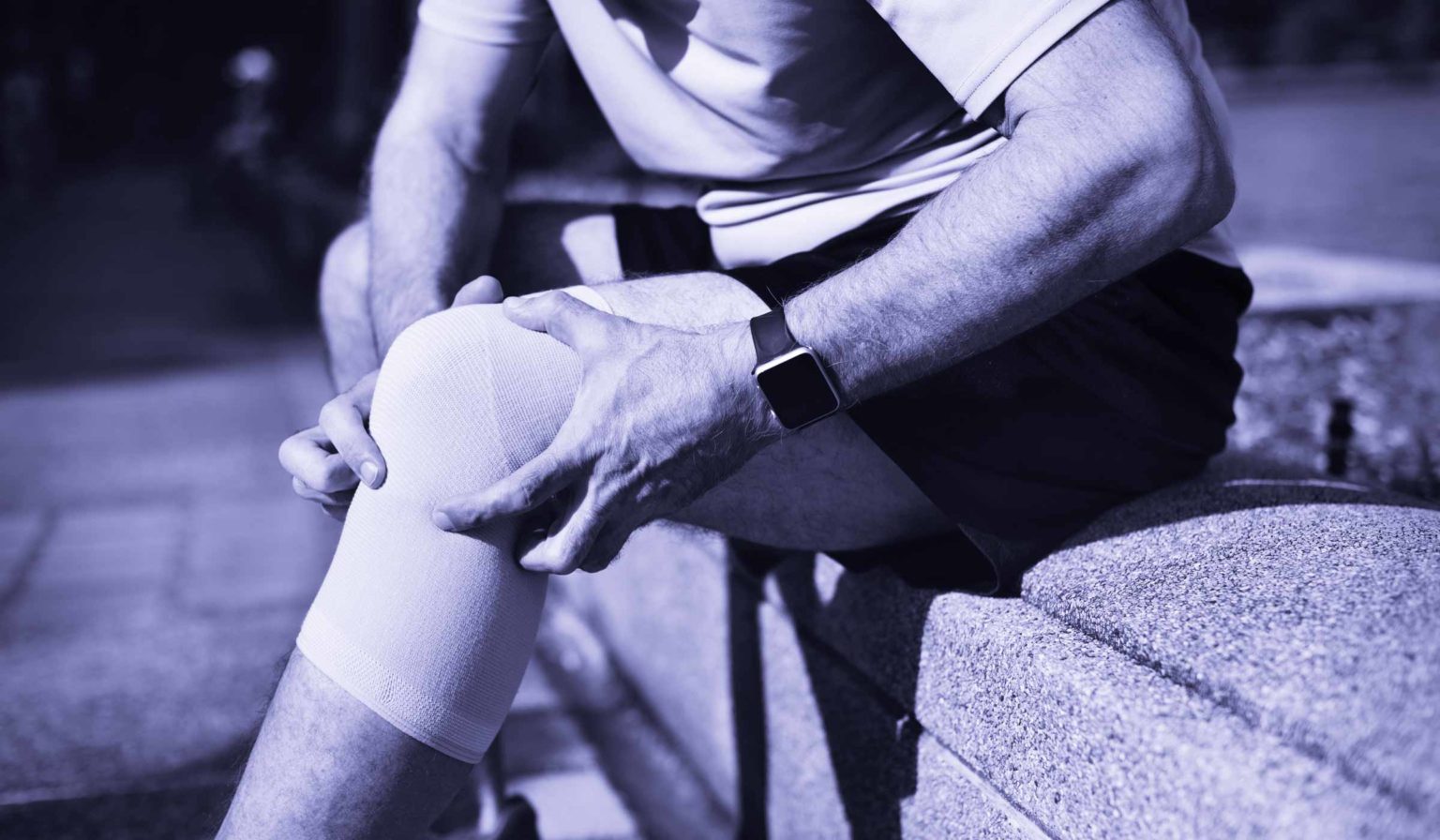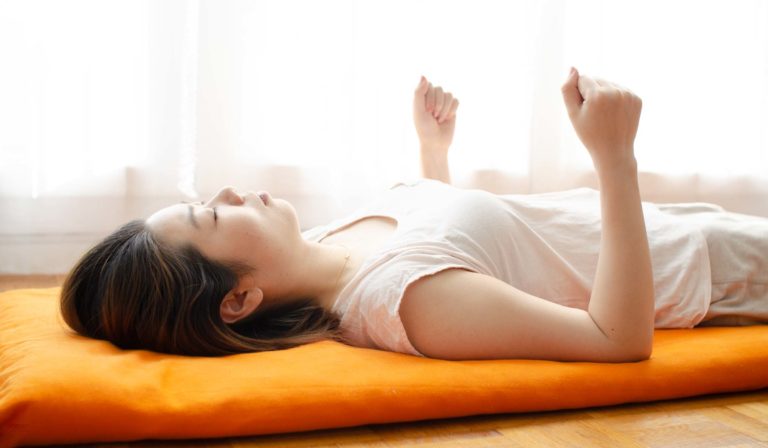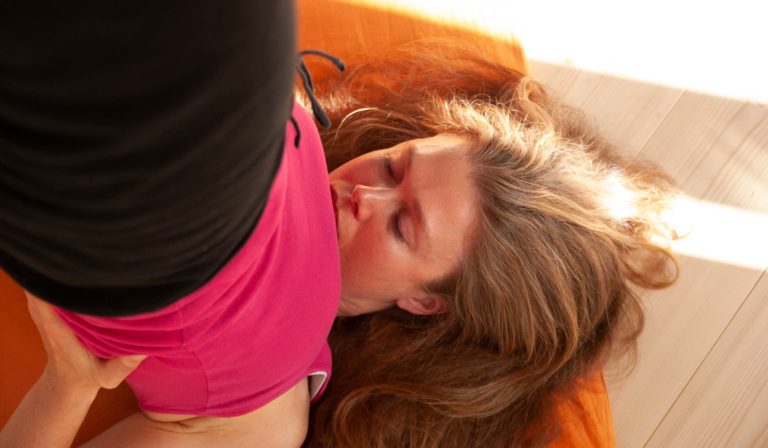Some years ago, I suffered from a chronic meniscus inflammation that stopped me from bending my knees more than 90 degrees. This condition lasted a couple of years, and the treatment offered by a prominent sports doctor had no effect. This post tells how I managed to naturally heal the inflammation myself, thanks to meditation, exercise and an anti-inflammatory diet.
When my first son was little, I, like all parents, went through a period during which I had little time to take care of myself. An old meniscus problem reappeared, which started getting worse. Slowly at first, then rapidly. Suddenly, I found myself with a left leg I could no longer bend.
I had dealt with the same problem some ten years earlier. I had a violent fever one night, and when I woke up the morning after, I felt pain in my knees. A podiatrist later explained that the angle between my feet and legs provokes an abnormal pressure on my meniscuses which could have played a role. I also suspected another reason. When I was new to yoga, I had recklessly experimented with some advanced meditation poses, such as the mulbandhasana.
Luckily, the first time my knees ran into trouble, I was doing my yoga teacher training, and I lived in an ashram. Thanks to yoga, my knees got better during the course of a few months. Then during a one-month kriya yoga retreat, they rapidly healed entirely. Under such conditions, it is easy to heal inflammation naturally.
The second time it happened, my life situation was far less favourable. Due to my obligations as a family father and a yoga professional, I knew that I did not have the time necessary for sufficiently intense yoga practice.
The sports doctor
This time, I decided to see a sports doctor. A friend warmly recommended a highly qualified physician. He was the official doctor for a French national team of a popular sport. After an X-ray, ultrasound and an MRI scan, he diagnosed me with a crack in my left meniscus accompanied by inflammation. According to my doctor, it was not a tear but more like a fissure—a classical case.
In the past, physicians used to operate this type of orthopaedic problem, but that was no longer the case, my physician explained. Instead he continued, today’s treatment of choice was an injection of an anti-inflammatory agent based on cortisone in the knee joint. That is how he treated high-level athletes, he told me. If the injection didn’t work, we would only then consider an operation. However, the results of meniscus operations were doubtful. It would be better to keep it as intact as possible to prevent the joint from wearing down long term.
I had been a bit sceptical of western medicine because of previous disappointments. I wasn’t keen on this injection. Much less on an operation. If the conditions had been better, I would have preferred to heal this inflammation naturally. Nevertheless, I got the shot, and the doctor told me to expect a good effect within a few weeks.
While waiting for the injection to work, I played with my son in a swimming pool. I made a wrong move in the water and immediately felt that something had happened in my other knee. A second MRI confirmed that I now had two cracked and inflamed meniscuses. The second knee’s state got even worse than the first one, and beyond 90° flexion, I felt intense pain. A cyst had formed inside the knee from the outflow of synovial fluid.
The failure of western medicine
I never saw any positive effect of that cortisone shot. I have a strong mind, so maybe it was partially due to a negative placebo effect because of my doubts; who knows? Anyway, since I didn’t want an operation, I had to look for an alternative.
The sports physician knew that I had a preference for natural treatments. With contempt, he said that trying to heal with plant medicine was doomed to fail. Since I was disappointed with his work, the idea of proving him wrong appealed to me.
For several years I wanted to try Ayurveda. It is a traditional Indian school of medicine with links to yoga. My meniscus problems were a brilliant occasion to test this healing method on a real and pressing issue. After discussing the matter with my wife (who is also a yoga and meditation teacher), we decided to spend our one-month family holidays in an ayurvedic centre in Kerala in India. Ayurvedic doctors recommend one month of intensive care to get optimal results.
The ayurvedic centre
I adored the centre, the monotonous rhythm of life, the lovely staff, and the radiant children in the poor neighbouring village. I also liked the strict diet. From what I overheard in the dining hall, this certainly wasn’t the case for everyone.
To get the most out of my stay, I switched off my phone and my computer. I isolated myself completely from the outside world, just as I would have done during a yoga retreat.
The daily programme was quite dense: one hour of yoga in the morning, the primary treatment before noon consisting of an hour and a half of massage with medicalised oils, a second minor treatment in the afternoon, another hour of yoga and sometimes a third treatment in the evening. On top of that, we got personalised ayurvedic medicine three times a day. The diet was also a big part of it and every person got meals decided by one’s personal doctor.
I only went to yoga once, though. It was very light and tailored for total beginners with particular needs. Instead, I practised alone, but only once per day when we could get a babysitter.
Targeting the inflammation
During the initial interview with my designated doctor, I had presented my health issues I wished to target. My number one priority was, of course, my knees.
I expected to see good results. If I had been sceptical about the effectiveness of the cortisone shot, I had a lot more hope for the ayurvedic approach. I was confident that this method would bring about a natural healing of my meniscus inflammations. I had pictured myself going back to France in total health. But time passed, and my knees did not improve.
However, my overall health increased quite a bit. I was full of energy for several months after the ayurvedic retreat. For some of my targeted ailments, there was a remarkable improvement. But as for my knees, the benefit was insignificant.
Waiting to heal naturally
After these two failures, I told myself that there was nothing I could do for the time being. I had to wait until I had time to heal my knees myself.
While waiting, I did everything I could not to make my condition worse. I carefully avoided any situation that would provoke pain. That meant sitting on a massive pillow while meditating and while teaching others. This was a bit embarrassing at times since sitting in a meditation pose is hard for beginners. I was not even close to being able to do what I asked of my own students.
I waited for a year and a half. During that time, the inflammation in both knees stayed stable. Then the day came when I was going to have enough time to do something about the issue myself. This is the exciting part.
My approach to healing my meniscus inflammations naturally
In France, kids start pre-school at the age of three. Then they are away from home the whole day, from 8:30 in the morning until 16:00. That meant that I now had the opportunity to take up a comprehensive sadhana. My wife agreed to split up the household tasks so that she took care of the morning chores. My mornings were thus free for meditation. And meditate, I did.
Many scientific studies have proven that meditation is efficacious for healing inflammation. The effects are so far-reaching that meditation even allows you to change your physiology on a genetic level. Scientists call it the genetic expression. Our genetic expression tells us which genes are active and which ones are switched off or passive. Meditation can alter the expression, for example, by switching off genes responsible for inflammation.
That is why I set out to meditate for five hours each day. I preferred to stay with basics, so I opted for simple breath awareness. Sitting on my enormous meditation cushion or a chair, I noticed the natural flow of my breath. While remaining utterly passive to any thoughts arising in my mind, I felt the air flowing in and the air flowing out of my nose—nothing else.
An alarm went off after each hour, and I then had a few minutes to stretch my legs or go to the toilet. In the morning, I did three or four such sittings, and I did the remaining sessions in the afternoon or the evening. I kept up this routine every day of the work-week. However, on weekends, I did not meditate at all. Instead, I spent my time with my wife and son.
Additional strategies to promote natural healing
In addition to meditation, I integrated a few other elements into my routine. I selected all elements specifically to support the healing of the inflammation in my knees naturally. All elements Every morning I did three easy exercises that physical therapists recommend for rehabilitating a meniscus. (link to videos). I also did 10 to 15 minutes of stretching all the muscles in my legs to relax them and increase blood flow.
Furthermore, my schedule included sports. Every second day I would go out to slowly run three to four kilometres in the Vincennes forest to the east of Paris.
The final element of my healing cocktail was an anti-inflammatory diet. I followed a diet recommended by Dr Weil. I read about it on his website, and it made sense to me. His regime was not far from my preferences and, what I knew from personal experience would be good for my body.
Dr Weil’s diet is based on vegetables. It is simple and varied. The most eye-catching characteristic is that you omit fast carbohydrates. Sugar is the fastest carbohydrate and a notorious inflammation driver. In Dr Weil’s diet, you leave out sugar and all products based on refined grains. In my case, I took it a step further and removed grains nearly altogether. I only occasionally ate whole grain rice. Essentially, I ate veggies three times a day.
Typically I would have found it challenging to keep such a diet, especially since my wife and my son ate their usual varied meals. Nevertheless, it was easy to stick to what I had decided, thanks to the long daily meditation hours.
The magic of natural healing
As I had foreseen, these measures as a whole turned out to be efficacious. However, after having suffered from chronic meniscus inflammation, the speed of the recovery surprised me. I noticed improvements on a daily basis and I could bend my legs more and more.
Very soon, I could put away my colossal sitting cushion and sit in vajrasana (the diamond pose) with only a blanket between my heels and my buttocks. The blanket got thinner and thinner and soon disappeared altogether. I progressed very carefully in order not to injure myself. Still, I could quickly sit in other yogic meditation poses. After two months, I had found my way back to total flexibility and could again sit in the full lotus pose.
Summing up
The body’s ability to self-heal is nothing short of fabulous when one creates the right conditions. With lifestyle changes and simple practices, you can resolve even stubborn health problems.
This story is just one example. During my career as a yoga and meditation teacher, I have encountered many instances of self-healing, some of them much more spectacular than this one. I am convinced that everyone can heal inflammation naturally by activating the power of their own body. What you need is time and commitment.




